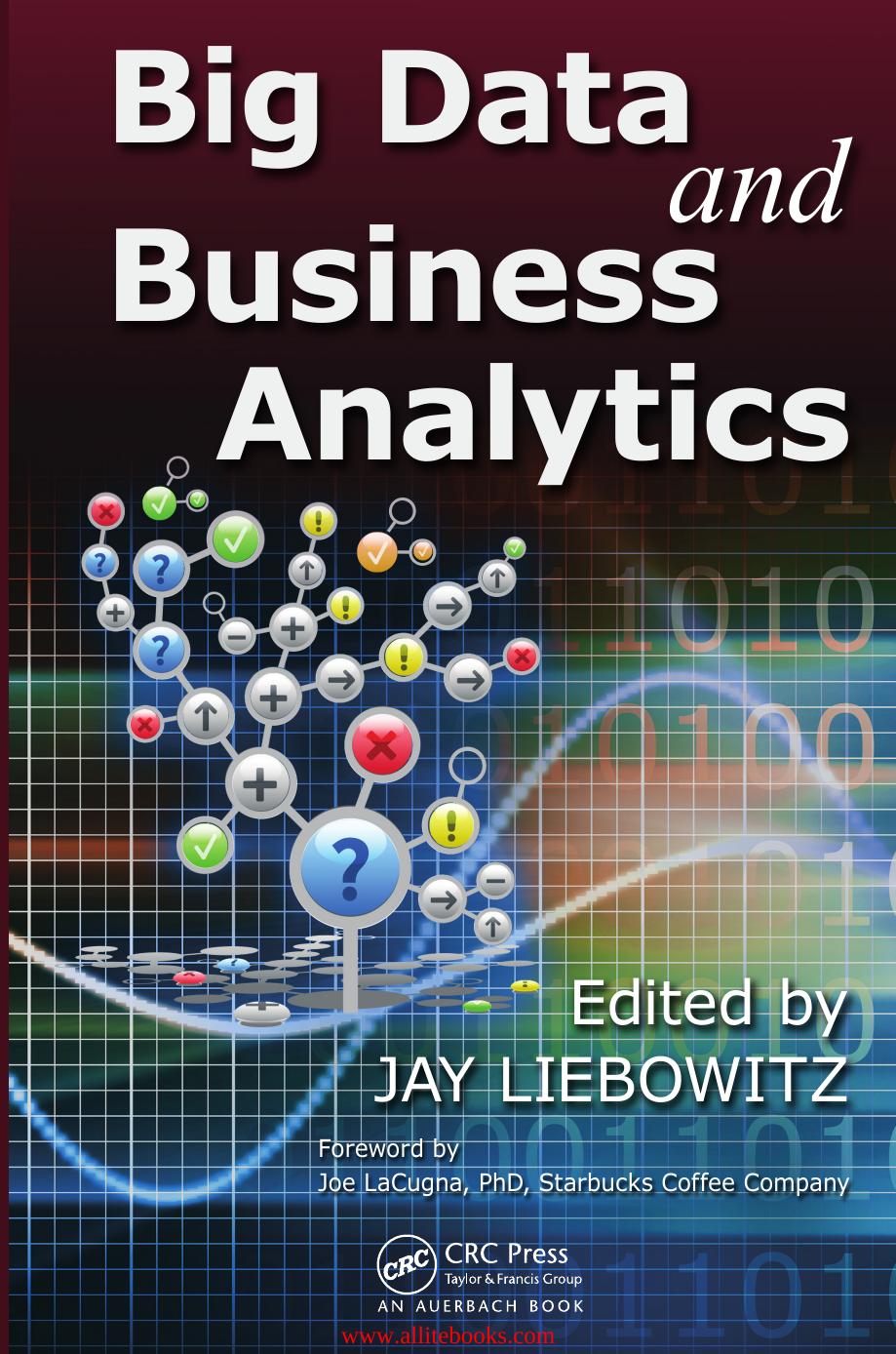Big Data and Business Analytics by Liebowitz Jay

Author:Liebowitz, Jay [Liebowitz, Jay]
Language: eng
Format: epub, pdf
Published: 2013-04-02T17:45:47+00:00
8
Innovation Patterns and Big Data
Daniel Conway and Diego Klabjan
CONTENTS
Introduction ....................................................................................................131
Contexts for Understanding Big Data .........................................................132
Big Data as a Natural Resource ................................................................133
Big Data as Big Digital Inventory ............................................................133
Big Data as a More Granular View of the Past ...................................... 134
Big Data and Organizational Challenges ................................................135
Big Data as a Role in Process Innovation ...............................................136
P- TRIZ: Repeatable Process Innovation......................................................138
Notation ......................................................................................................138
Examples of P- TRIZ and Technology ..........................................................140
Summary .........................................................................................................145
References ........................................................................................................146
INTRODUCTION
Big data is often generated by devices configured for collection based on the occurrence of events. Events can occur based on scan rates (collect yield from a combine every five seconds), from status change (pitch is a strike, count is now 3-1), or from rule execution (S&P 500 VIX > 24.5).
Domains such as finance and physics, where big data was first collected and analyzed, were the first to create new theories and innovative new
markets, and those innovations are now finding their way into domains
where data collection has recently become feasible. For example, the
financial options pricing method known as Black– Scholes is now used to estimate the future value of baseball players. These innovations are often the answer to questions formulated with innovation theory. Innovation
theory would suggest new domains where big data is now available, and it 131
132 • Big Data and Business Analytics
should allow for the creation of new markets based on predictive analytics applied over robust event histories. We look at these innovation patterns and apply them to the important area of global food supply with particular focus on the opportunities the agricultural market participants will encounter while moving from traditional manufacturing and distribution
to competing on analytics over big data.
Big data is a hype peddler’s dream come true. Big is somewhat ambiguous and modestly confident, yet invokes a sense of challenge. What’s big to me might not be big to you, and what’s big to you today might not be big to you next month. It is a fairly versatile term and thus likely enduring.
Data is somewhat dormant and passive, yet invokes a sense of opportunity. Data can be dense with value or sparse. It can be meaningless unless combined with other data. It can be useful at one time and useless at
another time. Perhaps Yogi Berra might have given clarity to the term as well as anyone: Data ain’t big until it’s big.
An economic approach might require coupling big data with analytics
and thus attempt to measure the derived value based on the computa-
tional effort expended. The cost side of this effort is often estimated with the usual suspects of CPU/ cluster cycles, storage costs, labor, and utilization rates for cloud services, for example. If we consider the three Vs of big data (velocity, volume, and variety), then our traditional measures primarily address velocity and volume. The variety of data implies the need for integration, and while we have improved data integration in practice, it remains an endeavor with domain- specific challenges.
The value side of the economic approach involves a transformation from
digital assets into actionable insights. The difficulty in measures of value is that one often doesn’t know how the assets will be leveraged in the future if at all.
Download
Big Data and Business Analytics by Liebowitz Jay.pdf
This site does not store any files on its server. We only index and link to content provided by other sites. Please contact the content providers to delete copyright contents if any and email us, we'll remove relevant links or contents immediately.
Algorithms of the Intelligent Web by Haralambos Marmanis;Dmitry Babenko(8585)
Azure Data and AI Architect Handbook by Olivier Mertens & Breght Van Baelen(7484)
Building Statistical Models in Python by Huy Hoang Nguyen & Paul N Adams & Stuart J Miller(7481)
Serverless Machine Learning with Amazon Redshift ML by Debu Panda & Phil Bates & Bhanu Pittampally & Sumeet Joshi(7358)
Driving Data Quality with Data Contracts by Andrew Jones(7117)
Data Wrangling on AWS by Navnit Shukla | Sankar M | Sam Palani(7115)
Machine Learning Model Serving Patterns and Best Practices by Md Johirul Islam(6843)
Learning SQL by Alan Beaulieu(6190)
Weapons of Math Destruction by Cathy O'Neil(6116)
Big Data Analysis with Python by Ivan Marin(5823)
Data Engineering with dbt by Roberto Zagni(4827)
Solidity Programming Essentials by Ritesh Modi(4454)
Time Series Analysis with Python Cookbook by Tarek A. Atwan(4290)
Pandas Cookbook by Theodore Petrou(3993)
Blockchain Basics by Daniel Drescher(3471)
Natural Language Processing with Java Cookbook by Richard M. Reese(3040)
Hands-On Machine Learning for Algorithmic Trading by Stefan Jansen(3006)
Feature Store for Machine Learning by Jayanth Kumar M J(2897)
Learn T-SQL Querying by Pam Lahoud & Pedro Lopes(2865)
